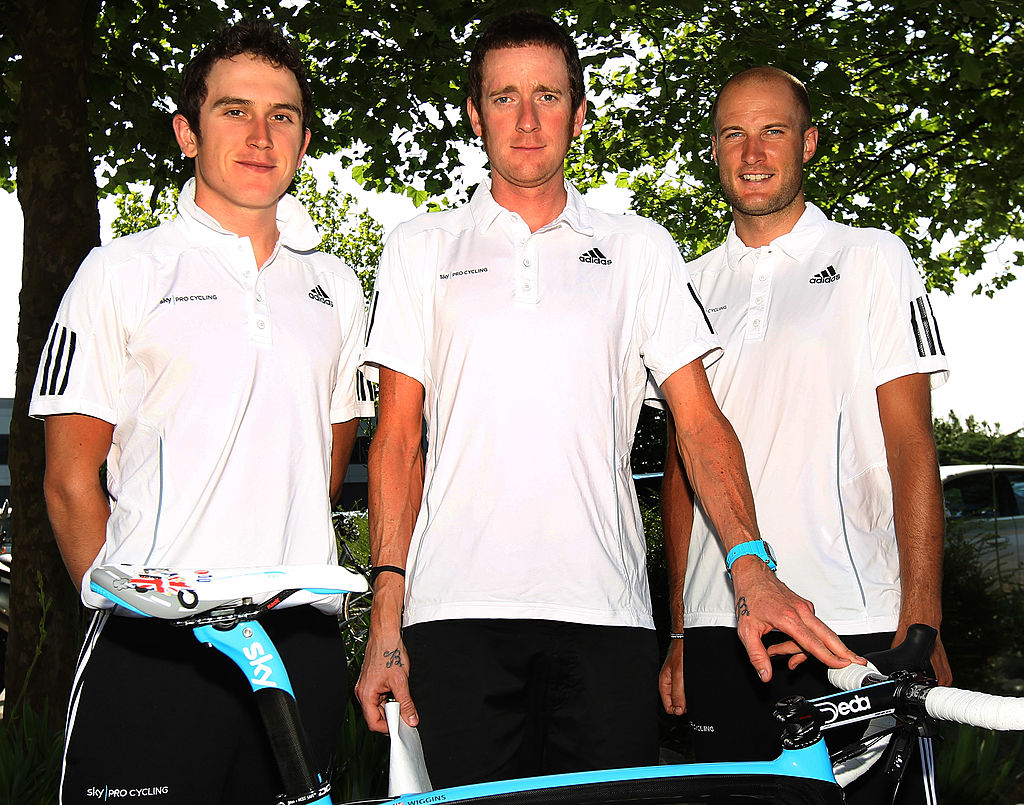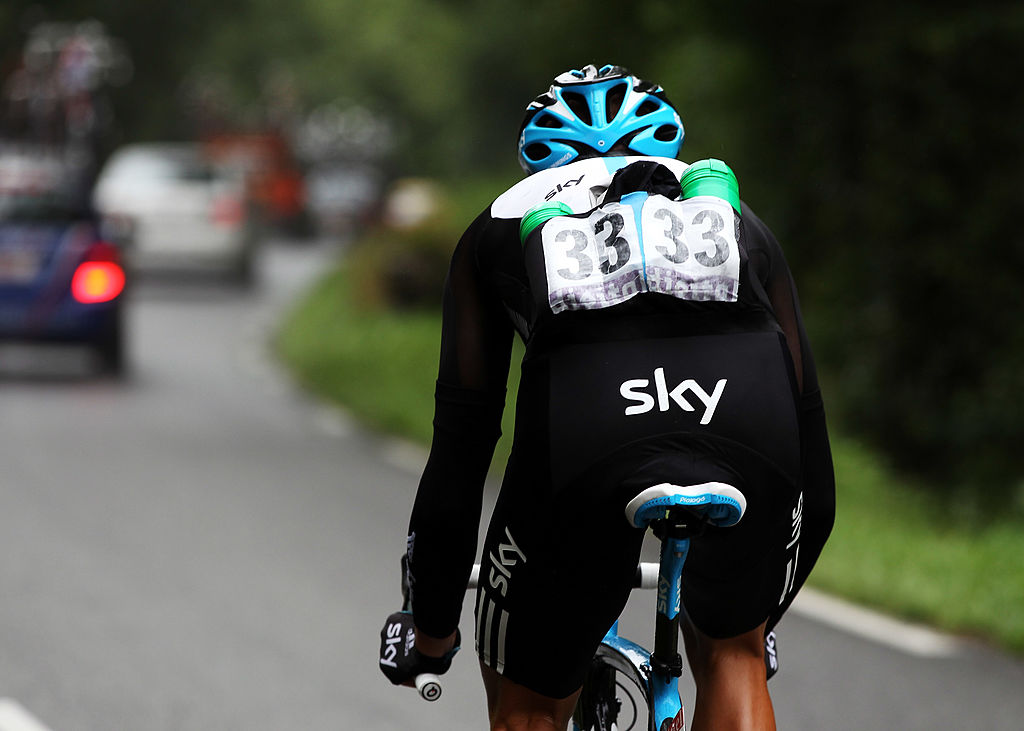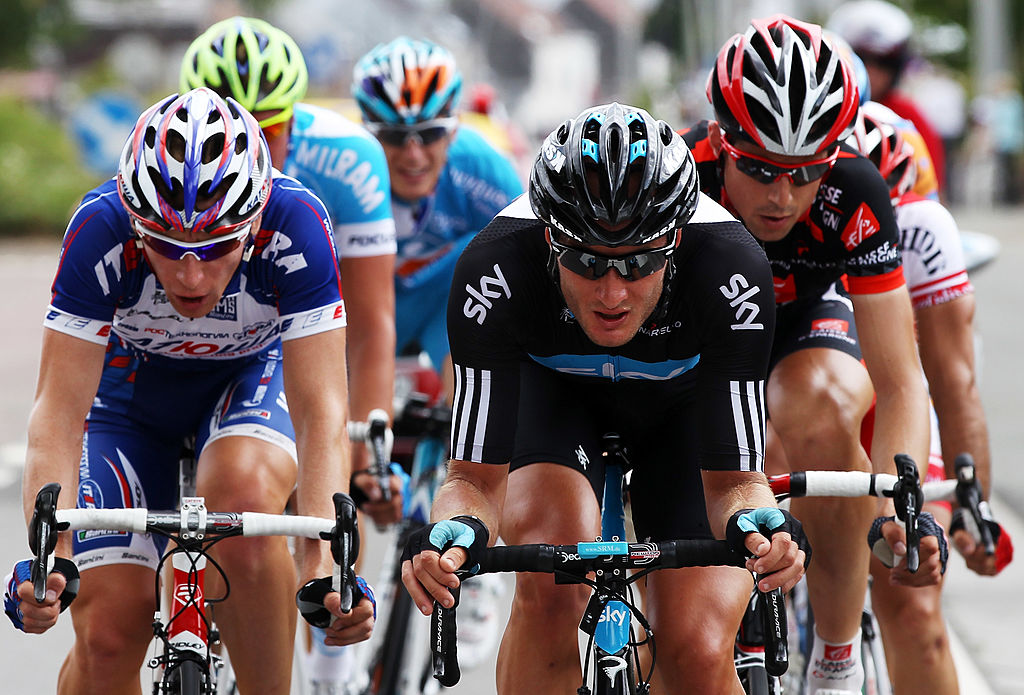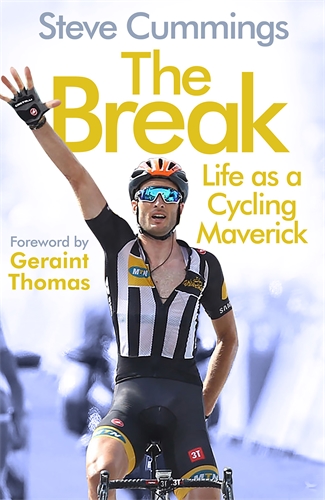The wrong kind of limits - A whole new world at Team Sky
An extract from Steve Cummings' autobiography 'The Break: Life as a Cycling Maverick'

The following is an extract from Steve Cummings’ autobiography 'The Break: Life as a Cycling Maverick,' available now on Amazon. Cummings, now a directeur sportif at Ineos Grenadiers, recalls his time as a rider with the squad under the Team Sky banner in 2010 and 2011.
When I signed for Team Sky as one of their riders in their first ever line-up, I had this idea that I was really going to explore how good I could be. On paper the circumstances seemed perfect because I was on board there with Dave B and Shane Sutton and I knew how ambitious they were. Although they had publicly given themselves five years to win the Tour, it was a goal from the first day the team started.
When it came to winning the Tour, Dave was always asking rhetorically, ‘Why can’t you do it?’ and certainly racing history was on their side. If you had wound back the clock ten years and looked at what Brailsford and British Cycling had achieved on the track for Great Britain in that time, Dave’s question back then had been, ‘Why can’t you win an Olympic gold?’ But he’d answered that himself, because he’d masterminded British Cycling’s track performances as they went from netting bronze medals and the occasional gold in the Olympics and Worlds to a scenario where if you made the team and you couldn’t get at least one gold, you were the odd one out.
So I was totally on board in Sky. I had faith in Brailsford. I thought they’d revolutionize cycling and I was keen to be a part of it. I looked at how far Wiggo had gone on the road and thought, given my past and his past on the track, that it’d be hard, but as I was in the right place and environment to explore my limits it didn’t seem out of the question that I could do something similar.
The process of getting into Sky had begun, oddly enough, when I signed with another team, Barloworld, in 2008 and had shown what I could do on the road whilst still on the GB track programme. Then it continued, equally oddly, when I was approached by another team, Astana, at the end of 2008 with an offer of a contract for two years. I flagged this interest of Astana up to Dave B, and that was when he confirmed that Sky was going to start in 2010; they’d seen how I raced and they wanted me as part of the squad. He also told me how much he was going to pay me and said that instead of Astana I should stay with Barloworld for another year.
In one way it was hard not to sign with Astana, because I really liked the people I knew in the team. But the squad’s Kazakh management side, which was obviously a very significant element, was a mystery to me.
So my idea was that I could and would get into a whole new world at Sky. I had a lot to learn.
Get The Leadout Newsletter
The latest race content, interviews, features, reviews and expert buying guides, direct to your inbox!

It’s a typical race day at Team Sky somewhere in the middle of the 2010 Tour de France, my first and the team’s first and we’re sitting on the team bus in the middle of the daily pre-stage meeting. Just as now, each rider has his own seat and table locker in the two rows of six, I’m sitting there in the middle near Geraint, Brad’s at the back... but the star of the show is the overhead projector, which they use for the whole of the meeting, at every meeting. Your picture comes up on the projector and it says ‘your role’ underneath. It’s always this military stuff: Brad as commander, Juan Antonio Flecha, our Classics specialist, is the tank driver, I’m down as ‘wingman’ – all this sort of shit. You’d have a list of things to do below your picture and my list is always enormous. First hour: only six guys in the break. Or only four. No riders from this team in the break. Or that team. Or that team. Once that’s done, keep Bradley out of the wind in this section. Get Bradley here in that section. Get bottles here. Get bottles there. Then there’s the final. On and on. It’s overwhelming. How am I supposed to memorize all that? I couldn’t. But then it comes to Brad and the projector flashes up ‘zero watts’. And you think ‘Like – really? How the fuck are you going to race the Tour with zero watts?’
The meetings are novel in their presentation format, which is at first refreshing but then it gets tiring, particularly as they’re really long too, and the upshot is I’m tired even before the stages have begun.
I was way too nervous to feel the buzz around the Tour. I know it’s there; for one thing it’s a sign of how big it is that I have to talk to journalists every day. But I found those interviews really hard because I didn’t have anything good to say. Basically, I wanted something to swallow me up because I know I’m not on top form and the Tour is the worst race in the world to be in poor shape. You want to be there at the Tour – who doesn’t? But not in these circumstances when I’m struggling and in a world of hurt.
On top of that there’s Sky’s race strategy to deal with, which for most of the Tour is the same as it’s been since January. We have one main mission, and that’s GC for stage races with Brad. But just because they’ve got one overriding goal and they’ve come out with these sweeping statements about winning the Tour in five years, you can’t get away from the really negative atmosphere that undercuts it all. Or maybe that’s only to be expected as even when Wiggo was lying seventeenth or worse in the Tour, they were still trying to race as if a multiple Grand Tour winner like Lance Armstrong was in the team. It might have been the necessary step they needed to get where they wanted to go, but at the time, if you added in the intensity coming at us from above, it was a challenge to tolerate.
It doesn’t actually help that, after two weeks in the Tour and six months of this strategy, the management deviate, totally, from their previous approach of the whole season. Suddenly, instead of GC with Brad, they realize they’re getting nowhere and they switch to a policy of ‘All right, now we’re going to try to win a stage.’ But it’s too late: there are almost only mountain stages left to race, meaning we’ve barely got any real opportunities even to get a consolation win.
We have had our chances before though. There was a first-week stage that went over some of the cobbled sectors of farm roads they use in the Paris–Roubaix Classic and I’d got up front after another team-mate, Simon Gerrans, gave me a hand. Geraint was already in on the move, and with two of us in the break, for sure there could have been a good outcome for Sky. But no. Instead, the team told me in no uncertain terms to drop back from the break and wait for Brad. So rather than me and Geraint riding off each other and one of us maybe getting away and increasing the team’s chances of winning a prestigious stage of the Tour, we came away empty-handed.
But that was the Sky mentality: rigid and robotic, or that was my perception. It was those kinds of moments, like on the Roubaix stage, when I realized, ‘I don’t want to race like this.’ It was taking all the fun out of racing and my attitude was: enjoy what you do or it can kill you! If I was having fun all the necessary sacrifices seemed effortless, but this was doing me in – physically and mentally.
What made it far worse was this strategy of ‘all for Brad’ had already fallen apart at the Giro, where at least initially we had done much better than in the Tour. He had won the opening prologue and then we had performed well by getting Bradley and some other guys from the team on a famous race-changing big break on the 260-kilometre stage to L’Aquila, the one that changed the race by nearly destroying the chances of favourites like Vinokourov and Cadel Evans. We’d not just worked perfectly as a team that day; we all knew the stage itself was something special – I remember the stage winner, Evgeni Petrov, saying as we rode along, ‘Today we change cycling.’ And we were really part of it, something of which the team could feel proud.
But then, as I already wrote in a previous chapter, Brad changed his mind about the Giro GC, and all that effort had been for nothing. By the Tour we were back to ‘all for Bradley on GC, come what may’. It was like the Giro hadn’t happened.
It wasn’t just about the team getting crap results in the Tour or shooting itself in the foot at the Giro, even in the smaller races I’d suffered from rigid robotic style in Sky’s strategies. At one stage race somewhere that first year, I’d been lying eleventh, which might not sound great, but I was in flying form and I knew there were some opportunities coming up for me to improve on that.
Instead, I was asked to ride for our sprinter and in the process ensure that on what were good stages for me to have a chance to get away, we stayed together as a bunch all the way to the line. I was so angry one day that all I wanted to do was drop everyone. Eventually, I rode on the front, all by myself, for 25 kilometres, and I went so hard it split the group. We didn’t win the sprint, either.
So it was a different version of the same old story: at a big team like Sky the management’s view was I wasn’t good enough to lead, and that meant I was always falling into this domestique’s role. Because I was good on the flat and OK on the climbs, everybody would say, ‘That’s great, Steve can pull. Steve can pull.’ End of story. But why did it have to be like that? My view was that I wasn’t good enough to be a consistent leader or GC rider. But I was hungry to win and I wanted to have fun trying, because that’s what made me happy and without happiness I would never have got the best out of myself. I hated the feeling of not doing that – it was my biggest fear.

To try to treat this issue objectively, Dave B likes to be in control, which is fair enough when you have the favourite and you are on a predictable course with few contenders like the Tour de France.
But that same strategy was even applied in a race like the Tour of Britain, which is all but impossible to control. Britain consists of one very hilly stage after another. The time trial, when they have one, is very short so you don’t get a clear pecking order from it, and on top of that there are only six riders in a team. I would have preferred to take risks, because I wanted to think and I wanted to improve and I wanted deep down to get the best out of myself. But they would focus on controlling the race a lot and end up fifth.
This serious mismatching of strategies filtered down to me, my morale and my performance. It wasn’t so bad in the cobbled Classics group, led by guys like Geraint and Ian Stannard, but in the Ardennes Classics/Grand Tours group with riders like me, there was a real sense of negativity. Then to make matters worse they packed me into far too many races: in the first half of 2010 I did the GP Marseilles, the Étoile de Bessèges, the Tour of Andalucía, GP Almeria, Paris–Nice, the Tour of Catalonia, the Tour of the Basque Country, the Ardennes, the Giro, ten days of Tour reconnaissance with six-hour rides most days, and then the Tour de France itself.
The attitude was ‘Steve’s going well, let’s put him in the Giro, let’s put him in the Tour, let’s put him here there and everywhere.’ Then the comments started that ‘Steve wasn’t on it at the Tour.’ But that was both harsh and skewed given the number of races I’d done.
It wasn’t just the race programme that went against me or the race strategy. On top of that I felt like I was being used as a guinea pig in a lot of things. To give one example, which I suspect was to act as a test run for Wiggins before they tried it on him, I trialled a super-restricted diet of 1000 calories a day. It was centred on what they called ‘fruit days’: in other words, two pieces of fruit five times a day and half a pint of skimmed milk for your protein, and that’d be it. Our nutritionist would measure your body fat levels and say, ‘OK, you’re 10 per cent, pop in a couple of fruit days and that’ll bring you back down.’
These were combined with a catabolic diet of no breakfast, ride your bike for up to five hours, then have 200–300 grams of meat or fish and salad for lunch and dinner. Five days on like that, then five days off.

The year Sky started I did that for three months at fortnightly intervals, and it certainly was effective in one way as I dropped to my lowest ever weight of 69.9 kilos. (Just to give you an idea of how extreme that is, at the Tour de France in 2015 and 2016, my two most successful years, my in-form weight was 75 kilos.) And on top of that I was really strong on short, steep climbs and going uphill.
Initially, I was happy to do this as I was keen to be as light as possible – what cyclist isn’t? But the benefits didn’t work more than short term because apart from not being super-healthy the problem with crash diets is there’s always a rebound and they aren’t sustainable. Your body ends up grabbing everything it can at a race, and then it becomes bloated. It just underlines that what you do at home needs to resemble what you do in a race, and when it comes to diet, I preferred sustainable practice – which 1000 calories a day, particularly when you’re racing really hard for seven months, definitely isn’t.
Overall, Sky’s ideas and plans were due to them being on a huge learning curve. What cracked me up about that was that I was thirty and I didn’t have time for ideas that I’d already tried in the track days and knew didn’t work or hesitated to try them again. Don’t get me wrong, I was all up for testing riders’ strength and trying to use a scientific approach, and I understood the importance of weight loss, so I tried all this off-the-wall stuff. But another part of me quickly had had enough of it and just wanted to do normal, sustainable things.
I used to look at certain riders and think, ‘Fucking hell, they’re always tanned and lean, and they’re in good shape from February to October. End of story.’ The foundations for my strategies were about trying to do the basics better than anyone else. Sky, on the other hand, had the right goals, maybe, but they were hell-bent on having a go at making round wheels square and seeing if that worked out this time for once.
I still had it in my head that if someone was going to win the Tour with Dave B, you’d follow him because he’d been so successful, and in my own way I was following. But if that attitude of mine was positive, there was another side of me that was kind of icy, that didn’t like being told what to do and if a sports director came up with some stupid strategy, I found it very difficult not to voice an opinion. Perhaps my opinion was legitimate, but at the time I didn’t have enough communication skills so I struggled to articulate myself and often my frustration spilt over. I questioned the rigour, I questioned the science, I questioned the people, I felt like I was running out of time and needed to go away and find a simple, tried and trusted methodology.
After the Tour went wrong for me and the team, in the autumn and over that winter, rather than try to boost my morale for the following season, Sky unintentionally crushed it. For the 2011 race programmes, they had each rider on a big chart on a wall at team HQ, with a pink label for guys provisionally down to do the Giro, yellow guys who will be doing the Tour, and the red guys will be doing the Vuelta. And the colour of my label? That was black. Because you’ve been blacklisted, Steve.
There will be a lot of people reading this, I’m sure, who are wondering that if I thought Sky wasn’t an efficient or effective team back then, why on earth am I working for the same line-up now? The answer to that one is easier than you might think: I’m talking about what the team was like over a decade ago, when Sky had just started and were still finding their feet, and when I was in a very different position in my career. Where we are now is, thankfully, a whole different story, and a wholly different time.
It helped that I never had a problem with Dave Brailsford. We didn’t always agree, but I understood and always respected that he wanted what was best for the team – not necessarily what was best for me. But that was when I realized I wasn’t there to win, I was there to be a robot, something that I couldn’t adapt to and I knew it would be best to leave. The feeling was no doubt mutual.
Ultimately, the biggest problem for me, though, at Sky in 2010, was that as a person and as a rider I was a square peg that couldn’t fit into any of the round holes. On top of which, up until the Tour I’d pop out these good results all the time, which actually threw them even more. I couldn’t win the Tour, I probably wasn’t going to be a super mountain domestique and I certainly didn’t like all the fighting on the front of the bunch all day, which was the other option on the table – to become a domestique working on the flatter stages. Where did I fit into that?
Steve Cummings’ autobiography 'The Break: Life as a Cycling Maverick,' is available now on Amazon.